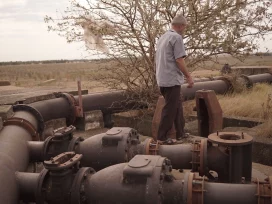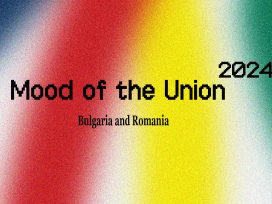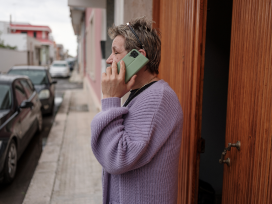 On the streets of Sofia’s Roma ghetto, tarmac is no more than a memory. Wretched shanties, built at random out of mud and broken brick, line crammed alleyways. Ill-smelling sludge flows along open gutters. To spot the links between local families, one need only follow the illegal power lines connecting their huts. Here, the very concept of infrastructure is as alien as astrophysics, while “the municipality” is a dirty word.
On the streets of Sofia’s Roma ghetto, tarmac is no more than a memory. Wretched shanties, built at random out of mud and broken brick, line crammed alleyways. Ill-smelling sludge flows along open gutters. To spot the links between local families, one need only follow the illegal power lines connecting their huts. Here, the very concept of infrastructure is as alien as astrophysics, while “the municipality” is a dirty word.
It may look like a snapshot from the Third World, but this is the Faculteta district of Bulgaria’s capital, and the scenes here are replicated across the country and in neighbouring Romania, both members of the European Union since January 2007. A recent boom has seen unemployment in both countries practically wiped out by the rocketing demand for labour. But this benign trend has barely touched the Roma. Racism, under-education and lack of qualifications have kept them hermetically sealed from the economic changes enjoyed by their countrymen.
Nor is this about to change. On the contrary, although most of the 45 000 residents of Faculteta are jobless, Bulgaria is set to import foreign workers to fuel its economic growth rather than integrate the existing Roma minority into its labour force. Officially, Bulgaria is home to 370 000 Roma. But non-governmental organisations believe this is well below the real figure, which they put at up to 800 000, or 10 per cent of the population.
During the last 15 years, many Roma from poor rural areas have migrated to the towns for a better life. Settling in poor and overcrowded districts, these have evolved into virtual ghettos. About 54 per cent of Roma now live in these mahali, as they are known in Bulgarian. About three-quarters never leave them.
Georgi Krastev, head of the Roma Integration Unit in the Ministry of Labour and Social Policy, agrees that the country faces a problem of severe economic segregation. “More than 90 per cent of the unemployed [in Bulgaria] are Roma,” he says. In August, his ministry reported that the jobless rate had dropped to a record low of 7 per cent and predicted the trend would continue. In Sofia, almost the only unemployed adults are those between jobs and the Roma, 60 per cent of whom lack work, according to the National Statistics Institute, NSI. Absorbed by other problems of the transition period and fearful of championing the rights of an unpopular minority, none of Bulgaria’s post-communist governments has taken substantial steps to improve economic mobility among the Roma.
Here and in other new member states, many now regret that more was not made of the chances offered by the EU pre-accession phase to increase the pressure for action. And while Brussels insists Roma integration must remain a priority for Bulgaria and Romania – and throughout the bloc – few believe the amount of funds that has been made available can remove the obstacles preventing upward mobility among the Roma. Roma communities in Balkan countries hoping soon to join the EU are taking note.
A regional problem, rooted in history
Bulgaria’s politicians are not alone in putting their heads in the sand. Scenes similar to those in Faculteta can be found throughout central and southeastern Europe. In Hungary, where Roma make up 6 to 8 per cent of the population of about 10 million, about 50 per cent are unemployed, compared to a national average of 7 per cent, according to a 2005 report by the Magyar Agora pollster. More than 50 per cent of Roma households in Hungary live below the poverty line, compared to a national average of 8 per cent.
The situation is similar in Serbia, where just over 60 per cent of its 300 000 Roma are considered very poor, compared to just over 6 per cent of the general population, according to an official report on Roma inclusion in 2006. The unemployment rate for Roma in all age groups and at all educational levels is three times higher than that of the non-Roma population.
In the Czech Republic, more than 70 per cent of Roma are jobless, compared to about 10 per cent for the country as a whole, according to a 2005 European Commission report. In Romania, where the 2 million Roma make up about 8 per cent of the population of 22 million, as many as 75 per cent of those of working-age are unemployed, according to a 2004 survey compiled jointly by the UN’s development arm, UNDP and the International Labour Organisation, ILO.
The roots of these problems go back centuries, says Rumyan Sechkov, historian at the Bulgarian Academy of Sciences and chair of Start for Alternative Civic Initiatives, a campaign group. The curiosity first aroused in Europeans by the Roma when they migrated in the fifteenth century from the Indian subcontinent quickly turned to outright hostility, he recounts, explaining that “the rejection of the Roma has its roots deep back in that era.” Many sought sanctuary in the European lands of the Ottoman Empire, where they were neither welcomed nor exterminated. But during the Second World War, around half a million Roma were murdered by the Nazis and their local allies in the new nation states of central and eastern Europe.
The survivors faced fresh attempts at forced assimilation from the Communist regimes that took power. In Bulgaria, the Roma language was suppressed, their music banned in public, and their nomadic lifestyle ended by a 1957 law ordering all citizens to register at a fixed address. Worse still, in Czechoslovakia, some Roma women were sterilised as part of a state policy to reduce their numbers.
In the early 1990s, as political and economic change came to the lands of the old Eastern bloc, the Roma suddenly gained recognition as a distinct ethnic minority. In several ways this was a positive development. But it coincided with the collapse of many social institutions and, as the most economically vulnerable group, the Roma were affected worst. The gap between them and mainstream society increased.
Let’s ignore the problem
In January 2007, as Romania and Bulgaria joined the EU, the Roma became the area’s biggest single ethnic minority, numbering between 8 and 10 million. But size does not mean power, and in the new member states, Roma remain at a distinct disadvantage, locked in a cycle of discrimination, neglect and exclusion.
“I do not say that all the Roma are dangerous, but most of them are,” says Anton Ivanov, a 22-year-old Bulgarian from Krasna Poliana, a neighbourhood that lies next to Faculteta. This August, five men were seriously injured there when a group of Roma men staged a revenge attack for the beating of a boy from their community.
The district is notorious for ethnic tension, though officially there is no such problem. Marko Popov, a 17-year-old Roma boy, heading home in Faculteta, says: “We live normally with the Bulgarians of Krasna Poliana,” adding, however, that “normally” means mutual contempt between Roma and ethnic Bulgarians, with arson attacks and fights on a daily basis. Officials deny such incidents stem from racism, classifying the August clash for instance as a routine disturbance. Similarly, another incident this August, in which a 17-year-old Roma boy was beaten to death by ethnic Bulgarians in the town of Samokov, was described by police as “a fight between youth gangs”.
Meanwhile, the prejudices of young men like Ivanov provide fertile ground for growing right-wing elements. Bojan Rasate, the head of the Bulgarian National Union, has become Ivanov’s hero, having recently initiated a national volunteer squad to “protect” the Bulgarian population “from Roma harassment and natural disasters”. “It is high time someone took measures against them, and we are so grateful to Bojan Rasate,” says Ivanov, his eyes glowing with enthusiasm.
As with other new member states from eastern Europe, the European Commission urged Romania and Bulgaria to implement a zero-tolerance policy against racism before joining the EU. According to Katharina von Schnurbein, spokesperson for Vladimir Spidla, the Social Affairs Commissioner who counts Roma issues as part of his portfolio, this included “legal follow-up of incidents occurring in Roma settlements and fighting the ill-treatment of people”.
But little change was brought to bear, and admitting that racism exists remains taboo. This, along with chronic neglect, has left the policies signed up to by the Bulgarian authorities, such as the “Decade of Roma Inclusion” or the “2007 European Year of Equal Opportunities for All”, a dead letter.
A walk through Stolipinovo confirms this impression. Lying on the outskirts of Bulgaria’s second city of Plovdiv, it is, with its 35,000 inhabitants, the second biggest Roma ghetto in Bulgaria. At lunchtime on a typical weekday, everybody is around and the streets are alive with clamour. Children play in the mud, men bustle about in small groups and women wash clothes in front of their apartment blocks.
But the inhabitants are chronically deprived and suffer from bad health. “We have had no running water for ten years,” complains a small, blue-eyed woman, her hair piled up in a bun. “All three of my children got hepatitis last summer as a result.”
 She goes on: “They have lice in their hair because I cannot wash them. Some people accuse me of not sending them to school. How can I send them in that state? I won’t send them!”
She goes on: “They have lice in their hair because I cannot wash them. Some people accuse me of not sending them to school. How can I send them in that state? I won’t send them!”
The health and safety problems so visibly present in Stolipinovo are replicated in Marchevo, a village notorious for its poor conditions in the Rhodope mountains of the south, near the town of Garmen. Its origins date back to the 1960s, when a clan of basket makers settled there in obedience to the 1957 decree. It has long been a source of local epidemics on account of its poor sanitation. “Only 500 metres of pipe were needed for this mahala to be plugged into the town’s water supply,” says Kalina Bozeva, head of the Inter-Ethnic Initiative for Human Rights in Bulgaria. “It was the responsibility of the municipality, but it only came about recently, as the result of an NGO project.”
Petar Dikov, Sofia’s chief architect, explains that areas populated by Roma were usually listed in urban plans as industrial zones, in order to exempt municipalities from having to build any infrastructure. It is much the same over the border in Romania, where, according to Magda Matache, head of a Bucharest-based Roma rights group, Romani CRISS, such villages and settlements commonly have no running water. “People there can only dream of a sewage system,” she says. “They have to walk miles every day to the nearest well to bring home water for their families.”
Failure starts at school
Among the many mistakes and omissions made by the Bulgarian government with regard to the Roma, none was so crucial or so devastating as the way it mishandled the issue of schooling. A policy of effective segregation has deprived generations of Roma a chance to advance towards equal participation in the labour market.
In the Communist era, Roma could only study in neighbourhood schools geared to preparing them for blue-collar, low-qualified jobs. Subjects taught in “normal” schools, like mathematics and history, were omitted.
“They produced generations of poorly educated people,” says Krasimir Kunev, head of the Bulgarian Helsinki Committee. Today almost 70 per cent of Roma children continue to study in de facto segregated schools, according to a 2006 Bulgarian Helsinki Committee report. This, he explains, also made Roma the group most vulnerable to economic depression and high unemployment in the post-communist transition. And although the state became aware of the extent of the problem in the early- and mid-1990s, it has done little to tackle it beyond providing welfare.
“This was a huge failure,” Rumyan Sechkov maintains. “It was the easy solution; people with no qualifications remained under-qualified and marginalised.” Meanwhile, according to the historian, ordinary Bulgarians found the welfare payouts unfair, which incited social tension.
The scale of the problem has kept growing, entrenching a culture of dependency. “Now we are facing a national problem because a whole generation of Roma has grown up, never seeing their parents get up in the morning and go to work,” Sechkov maintains.
In 2006, 58 per cent of Roma households were receiving some form of social aid, according to the labour ministry.
But this is about to change. From 1 January 2008, new rules will limit the period under which anyone can receive welfare to 18 months. While designed to reduce abuse of the system, critics insist the development will have been in vain if it is not accompanied by polices that target poor education and unemployment.
Roza Tzvetanova, 54, is sitting on the kerb in front of her home in Stolipinovo. Her head wrapped in a bright pink scarf, she rolls tobacco in her lap as she describes how she and her five children survive on social benefits, she without a job, her husband in prison. When she hears she will soon have her welfare cut off, she becomes furious: “Are they crazy? They are trying to exterminate my children and me! No one wants to employ a 50-year-old woman with elementary school. Don’t they see this?”
Bulgaria is not alone in the region in failing to offer its Roma a decent education. In recent decades, standards have remained poor across Southeast Europe, giving Roma few chances to escape poverty and participate in society on an equal footing. But while other countries in the region have taken the first steps towards breaking this vicious circle, Bulgaria continues to neglect the issue.
According to the 2001 census, 20 per cent of Roma in Bulgaria aged 20 or above remain totally illiterate. But although this number is growing, the Ministry of Education appears to have no strategy to tackle the problem. In 2002, for example, the government issued an order that ethnic minority pupils be integrated into the mainstream, but failed to require municipalities to comply. And according to Kunev’s 2006 report, these did not do so.
Romania’s authorities are more pro-active, and as far back as 1993 they adopted affirmative action measures to increase the enrolment of Roma into high schools and universities. As a result, 400 Roma students were admitted in the 2005-2006 academic year to universities.
Magda Matache also describes Romania’s affirmative action policy as successful, citing reports that more Roma are visiting schools and more are graduating. While the results will only become clear in the long term, she believes the first effects are already emerging, as those now receiving a decent education return as role models to their communities or stay in the cities and find jobs. “Their jobs are either in institutions or the civil society sector [rather than business], but it is still a step forward,” Matache maintains.
In Serbia, affirmative measures are also being taken. According to the 2002 census, almost 62 per cent of Serbian Roma failed to complete elementary school, while less than 8 per cent completed secondary education, and a miniscule 0.3 per cent, higher education. However, the government has recently allocated extra budgetary funds for educational bursaries for Roma students.
The results have been dramatic, especially when the number of students enrolled in high schools is compared over two consecutive years. “In 2005-2006, we managed to enrol 88 Roma students in high schools, while the number in 2006-2007 was 260,” says Ljuan Koka, director of the Secretariat for Roma Strategy in Serbia.
An untapped source of labour
Experts agree that a main precondition for improving socio-economic prospects among the Roma is to cut the high rate of unemployment.
The irony is that countries like Bulgaria are crying out for workers. In fact, according to a recent World Bank report on eastern Europe, Bulgaria risks a slowdown in economic growth if it does not address its shortage of both skilled and unskilled labour. And while it suggests better utilisation and education of domestic workers “through reforming the educational systems and improving domestic mobility,” it also states that workers should be brought in from abroad.
Evgeni Ivanov, of the Confederation of Employers and Industrialists in Bulgaria, says the country is foolish to hunt for foreign workers while ignoring an untapped pool of labour at home. “Bulgaria has all the financial and human resources it needs to get the Roma integrated into the mainstream labour market,” he points out.
Ivanov predicts that the labour ministry will have about 1 billion euros at its disposal from EU Structural Funds to spend on programmes targeting Roma. “But we have no information that the ministry is actually working on the matter,” he adds. “We only hear them talking in the future tense.” Ivanov says the business community should support proactive measures to help Roma into work. “As employers, we do not mind [workers’] ethnicity or nationality, it’s the skills that are important.” But there are few signs of governments in the region actively working to improve the Roma community’s job prospects. In Serbia, Bulgaria and Romania, the authorities have failed to find a working formula to improve their chances through training schemes, for example.
Romania started targeting the Roma at job fairs in 2001, but these have not led to significant results. “Neither we nor the labour ministry campaigned enough among the Roma community, and in the end, while employers showed up [at the fairs], the Roma did not,” says Gelu Domenica, head of the Impreuna Agency for Community Development in Bucharest. The same thing happened in Bulgaria: although job fairs have been held since 2005 in Roma districts, the results have been negligible. And labour ministry official Georgi Krastev admits that government-sponsored courses have so far reached no more than 4000 Roma.
“These are only temporary solutions,” says Georgi Georgiev, 46, who attended a job fair in Stolipinovo’s school two years ago. Together with his 20-year-old son, Iliya, he found a job sweeping up waste at a building site in Plovdiv. But when the building was finished a few months later, both returned to their all-day card games in the ghetto. Besides, “only a few people from the neighbourhood went to the job fair, since almost no one knew when and where it would take place,” adds Georgiev. “I remember that the labour ministry officials, employers and journalists together outnumbered the Roma who attended.”
Don’t count on Brussels
As Serbia looks forward to membership negotiations with the EU, many see this as an ideal time to put relations with the Roma onto a new footing. Activists and rights groups in particular are relying on external pressure to nudge state policy towards Roma in a positive direction. Ferhad Saiti, head of RTV Nisava, an NGO, says the EU will be the best thing to happen to Serbia’s Roma. But the recent experiences of Bulgaria and Romania should serve as reminders that Saiti’s optimism may well be misplaced.
Serbia’s neighbours both underwent radical reforms as a result of the EU membership negotiation process. But no sustainable solutions were found for the problems of their respective Roma minorities. Pressure from Brussels proved insufficiently strong to bring about real change and is decreasing now Bulgaria and Romania are members.
In Romania, the poor situation of the Roma was mentioned in several pre-accession monitoring reports that were “pretty harsh” according to Radu Motoc, of the Soros Foundation in Bucharest. In September 2006, the European Commission noted “cases of institutional violence against Roma, such as police raids and evictions in Roma communities, without providing them with alternative accommodation”. In Bulgaria, it expressed concern that the governmental approach to non-registered settlements, mainly of Roma, had “led to tensions”, adding: “Further efforts are needed to combat all forms of intolerance”.
But beyond issuing critical reports, Brussels did not bring about much change in the status or prospects of the Roma. On paper, both Romania and Bulgaria now comply with EU standards on human rights, employment, housing and education.
While the Commission’s Katharina von Schnurbein describes how Brussels “worked closely with Bulgaria and Romania to set up various support programmes which aim at improving the housing, education and health situation of Roma,” Radu Motoc says the EU approach was deficient. “There were sectors that were totally left out [in the Romanian accession process], such as the social sector. Like the Bulgarians, we focused on anti-corruption and on reform of the judiciary.”
In Bulgaria, Kalina Bozeva fears the slow steps taken towards improving the position of Roma will tail off as pre-accession, external, pressure on the government relaxes. Her human rights organisation is one of a group trying to engage Europe in pushing Roma integration to the top of the political agenda. In Romania, NGOs have lobbied for the appointment of a minority commissioner at the European Commission, convinced that Commissioner Spidla’s brief is too wide. But in vain. “For now it is only a dream,” admits Dominica.
The European Commission rejects accusations that it has eased off on Roma, citing the support of its Structural Funds for their inclusion. “[T]he Commission is working very closely with Bulgaria and Romania to ensure that the key challenge of Roma inclusion is taken on board in both planning and implementation,” says von Schnurbein. But seen from a different angle, the commitment seems dubious. As Gruia Bumbu, head of the Romanian National Agency for Roma, points out, the 240 million euros spent by the Commission over the past decade on Roma inclusion programmes comes to about three euros a year for every Roma, “while it offers an annual subsidy of 32 to 35 euros for each cow.”
Roma as an asset, not a liability
Against this bleak background, some experts are calling for a new, more innovative, approach to Roma across central and eastern Europe, saying the current welfare-centred approach not only ruins lives but costs too much money.
Bulgarian economists Lachezar Bogdanov of Industry Watch, a business consultancy, and Georgi Angelov of the Open Society Institute, in a report entitled Integration of the Roma in Bulgaria, say a more proactive approach, involving a short-term increase in government spending, would expedite the mobilisation of the Roma into the labour force, and result in overall budget savings within only ten years.
They say that the half-a-billion euros Bulgaria will spend over the next ten years on programmes specifically for the Roma could generate a return of 7.5 to 15 billion euros if it were invested more wisely – that is, in building skills.
“If this was a real estate project, private entrepreneurs would greedily take it since the investment would be seen as worthwhile,” Bogdanov says. “But Bulgarians, and especially the state, do not consider the Roma minority as potential taxpayers or as a future source of labour force and GDP.”
Gelu Domenica agrees that the existing approaches of governments in the region have failed. “We must change our discourse from the human rights perspective to reasons to invest in Roma communities,” he argues. “We need to make the state aware that labour in the Roma community is cheaper and easier to find than bringing in labour from abroad.”
Government representatives freely admit the case for Roma economic empowerment – but then all too often pass the buck. Thus, Georgi Krastev argues that while Roma economic integration is a must, “it’s not the [central] state’s job. The municipalities should be the initiators.” He fails to mention, however, that Bulgarian municipal budgets are allocated by central government.
All sectors of society, it appears, agree on the need to mobilize the economic potential of the Roma in the twenty-first century and accept that this is only possible through long-term, consistent investment in the community. But neither national governments nor Brussels look ready to take the required lead in bringing this about.
Third World scenes from Bulgaria’s Roma ghettos seem destined to remain part of Europe’s landscape for years to come.
This article was written while Nikoleta Popkostadinova was a fellow of the Balkan Fellowship for Journalistic Excellence 2007, a programme initiated by the Robert Bosch Stiftung and ERSTE Foundation in cooperation with the Balkan Investigative Reporting Network.

 On the streets of Sofia’s Roma ghetto, tarmac is no more than a memory. Wretched shanties, built at random out of mud and broken brick, line crammed alleyways. Ill-smelling sludge flows along open gutters. To spot the links between local families, one need only follow the illegal power lines connecting their huts. Here, the very concept of infrastructure is as alien as astrophysics, while “the municipality” is a dirty word.
On the streets of Sofia’s Roma ghetto, tarmac is no more than a memory. Wretched shanties, built at random out of mud and broken brick, line crammed alleyways. Ill-smelling sludge flows along open gutters. To spot the links between local families, one need only follow the illegal power lines connecting their huts. Here, the very concept of infrastructure is as alien as astrophysics, while “the municipality” is a dirty word. She goes on: “They have lice in their hair because I cannot wash them. Some people accuse me of not sending them to school. How can I send them in that state? I won’t send them!”
She goes on: “They have lice in their hair because I cannot wash them. Some people accuse me of not sending them to school. How can I send them in that state? I won’t send them!”




